Another project - Philco 71
Posts: 1,190
Threads: 50
Joined: Oct 2017
City: Allendale, MI
Posts: 15,837
Threads: 554
Joined: Oct 2011
City: Jackson, NJ
Nice shape it is in.
The NC disease usually affects the smaller coil which is easy to rewind.
People who do not drink, do not smoke, do not eat red meat will one day feel really stupid lying there and dying from nothing.
(This post was last modified: 04-26-2020, 10:52 AM by morzh.)
Posts: 1,190
Threads: 50
Joined: Oct 2017
City: Allendale, MI
Sometimes you just gotta chuckle at assembly technique. The 240K resistor measures around 350K. there is a parallel resistor hidden underneath it. The rest are all in spec.

Posts: 15,837
Threads: 554
Joined: Oct 2011
City: Jackson, NJ
This 240K - 350K mistery is...ee discussed it in my 570 thread recently.
It is just weird.
People who do not drink, do not smoke, do not eat red meat will one day feel really stupid lying there and dying from nothing.
Posts: 1,190
Threads: 50
Joined: Oct 2017
City: Allendale, MI
Yes it is weird. that one went way up in value, several others went quite a bit down. Gotta wonder if some of the original tolerances were really 30 - 40%. I can see them going up in value, but why down?
Posts: 1,190
Threads: 50
Joined: Oct 2017
City: Allendale, MI
So, I have the radio up and running. Seems to be working OK now. It was a bit of a chore, though. Seems the Osc/mixer is a bit sensitive to coil rewinds. Rewound the coil even though it worked prior to disassembly. Close inspection revealed green wire due to the nitrocellulose. So I rewound. The original wire measured out to be 37 or 38 AWG. I used 37 with 35 turns. The oscillator would run with the tuning control below about half. Died above 1100 khz. I could watch it on the scope reduce amplitude quickly and die. So, I rewound it again using 34 AWG thinking the cloth covered original wire gave a bit more spacing (I read somewhere here that they usually use a heavier wire for that reason). Now the oscillator gave a better sine wave but died at 900 khz instead. Hmmm. Decided to remove 5 turns of wire and try again. Voila, the oscillator worked all the way across the band but was weaker at the high end. I removed 2 more turns and then the oscillator was more consistent. Removed 2 more turns and now the oscillator was stronger at the high end of the band. I added 3 turns ( a little more spaced as I had to make room for the splice) and now the oscillator is fairly consistent across the band with a nice sine wave. I took the signal for the scope off the cathode of the 36 osc/mixer tube. I get good sensitivity all across the band now but it seems this radio is very sensitive the to settings of the antenna and RF trimmers. If not in a slightly compromised position, I get a lot of whistling between stations. If anyone has insights into this, PLEASE educate me!
Here's pic of the almost finished chassis. You gotta love the globe tubes!
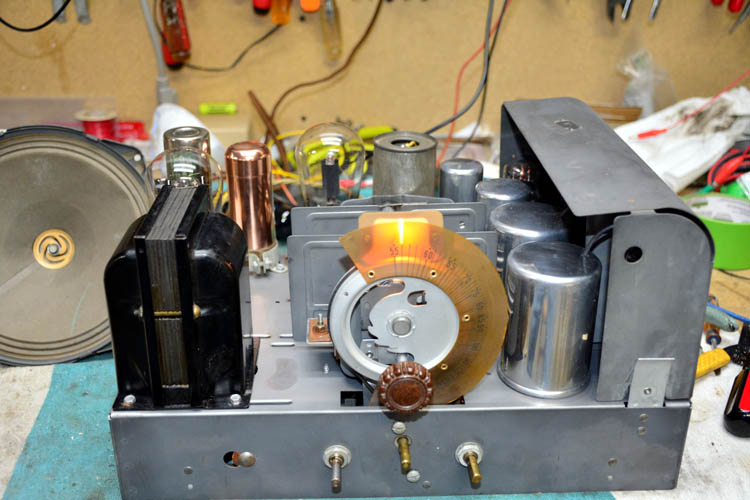

Here is the rewound coil for the second time:
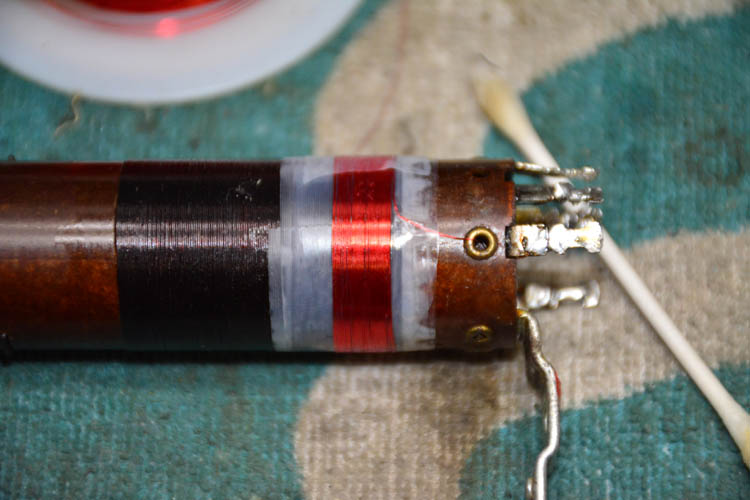
The final issue I've been dealing with is the output #42 tube. If you look at the photo, it looks as though the screen grid is glowing, and I think it is. The screen voltage and the plate voltage are normal according to the voltage chart. The screen is connected directly to the return from the field coil and so is higher than the plate since the plate voltage is dropped by the output transformer. I tried a NOS 42 I had and initially, I thought it was doing the same thing. So I tried to reduce the screen voltage by inserting a resistor. I got it slightly below the plate voltage but still no change. After close observations, I decided that on the NOS 42, what I was seeing was actually a reflection of the cathode on the bright wires of the screen. I don't think that is the case with the globe 42. I suspect that this tube, even though it measures fine on the tester, is not long for this world. I am certainly no expert in this stuff so if any of you have input, I'm all ears!!
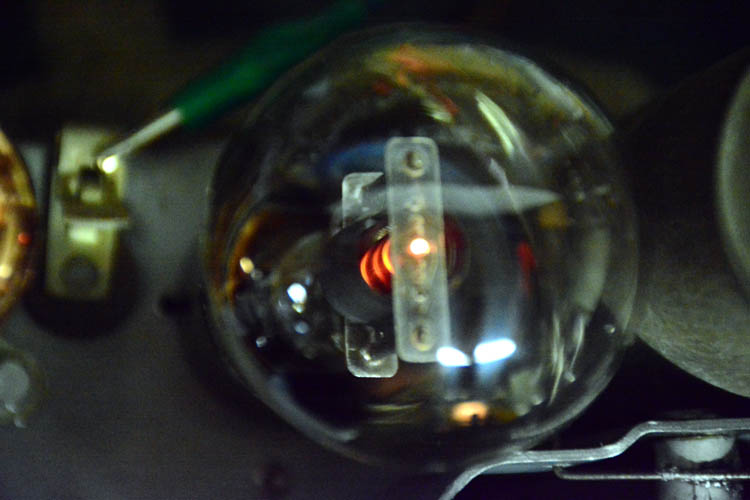
Posts: 105
Threads: 17
Joined: Mar 2018
City: angeles city,philippines
im not in your league technically,but i was reading on a forgotten uk webpage that carbon resistors absorb moisture from the air i guess and become less resistive after long periods of disuse. it begs the question, "what happens as they warm and dry out.or do they?" nice radio i wish i had access to sets that nice.
(This post was last modified: 05-01-2020, 08:42 AM by falcon123.)
Posts: 1,190
Threads: 50
Joined: Oct 2017
City: Allendale, MI
Seems everything is working. I got rid of the whistles when approaching a station by slightly detuning the IF trimmers. Not sure what is happening there, some sort of hetrodyning. Component layout and wire layout is about the same as original. Perhaps still something with the oscillator coil. I even confirmed that the osc. frequency is above the tuned frequency.

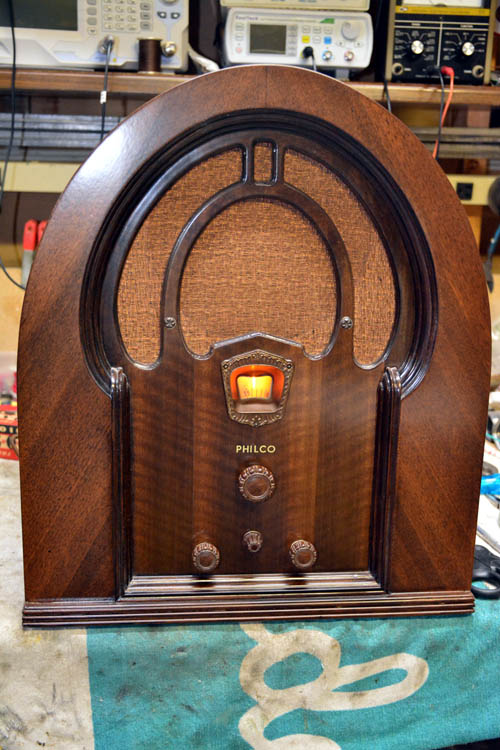
Sitting on the bench with her older sister, the 70. I like the style of the 70 better. The 70 is original finish, the 71 was already refinished when I bought it at the auction. Quite a nice job. The 71 definitely sounds better. Less distortion.

Posts: 4,383
Threads: 412
Joined: Jun 2011
City: Boston
State, Province, Country: Massachusetts
Looks might T fine to me, a real swell job. As good as when it came home from the Philco Dealer. 
Paul
Tubetalk1
Posts: 15,837
Threads: 554
Joined: Oct 2011
City: Jackson, NJ
You might like 70 better because there are way less of famous Combs cabinets (pretty much 70 and 90) whereas there are quite a few radios have Schuler cabinets, and so the uniquness of those is not as ...unique.
I like 90 the best (not that different from 70 but I think it is a bit more refined).
From Schuler cabinets...I like them all.
People who do not drink, do not smoke, do not eat red meat will one day feel really stupid lying there and dying from nothing.
(This post was last modified: 05-01-2020, 09:55 PM by morzh.)
Users browsing this thread: 1 Guest(s)
|
|
Recent Posts
|
|
New Philco Repair Bench
|
| Morzh is correct. The repair bench on our website is an archived image of chuck’s original site. He no longer provides s...klondike98 — 05:32 PM |
|
Made mistake & did not label connection
|
| Excellent information. It is all starting to come together now and your explanation really helped since I noticed that ...georgetownjohn — 04:39 PM |
|
Made mistake & did not label connection
|
| Hi John,
I don't have this radio, but I can supply some info:
Based on your pic, pins 7,8 and 1 are used together, go...MrFixr55 — 02:02 PM |
|
New Philco Repair Bench
|
| As far as I know, the Repairbench does not work, and has not been working in a while.
Chuck (we had that campaign looki...morzh — 01:33 PM |
|
Radio city products 664 schematic request
|
| Need a schematic or manual for the 664. The 663 may be similar.daveone23 — 12:38 PM |
|
New Philco Repair Bench
|
| Thanks Gary.dconant — 12:16 PM |
|
New Philco Repair Bench
|
| I tried accessing the site through our library and got the same response. It's reported to our tech gurus. GaryGarySP — 11:50 AM |
|
New Philco Repair Bench
|
| I am sure this is the archive, and not the Chuck's site.morzh — 09:50 PM |
|
Made mistake & did not label connection
|
| It's not like we are good friends with that wire and can tell it from other ptetty identical looking wires.
Why'n't you...morzh — 09:49 PM |
|
Made mistake & did not label connection
|
| I'm not sure why that wire wasn't covered in the video. I'm pretty sure the 6A8 won't work until that pin is grounded. Y...RodB — 09:47 PM |
|
Who's Online
|
There are currently 4307 online users. [Complete List]
» 2 Member(s) | 4305 Guest(s)
|
|
|

|
 
|
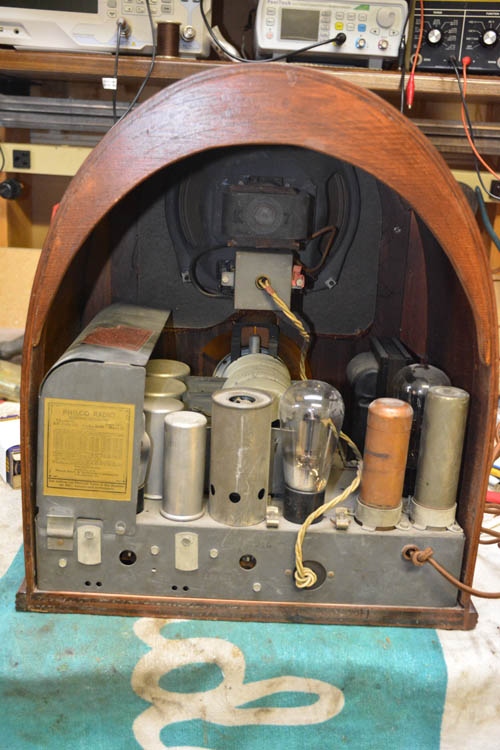

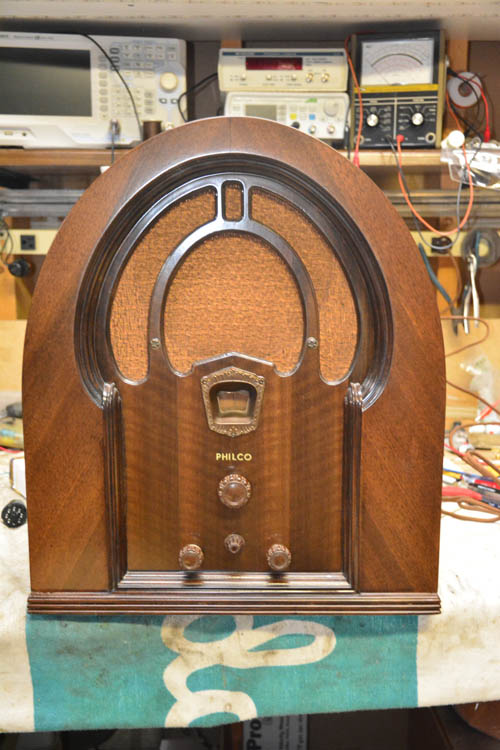




![[-] [-]](https://philcoradio.com/phorum/images/bootbb/collapse.png)


